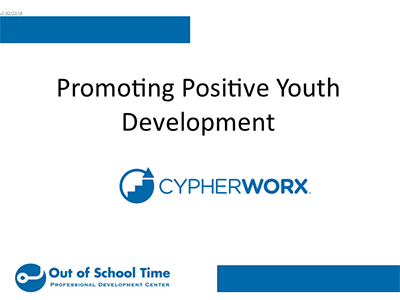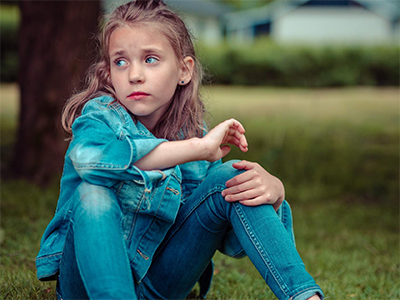 |
OSTPD - Supporting Attendance through After School Programming |
1.00 |
This training will cover a number of areas regarding how after school programs can support youth attendance in school. By looking at and exploring the connection between after school programming and attendance in school, we see how after school programming supports attendance at school as well as how to coordinate with the school in order to maximize the positive impact of after school on school attendance through collaboration. |
 |
OSTPD - Promoting Positive Youth Development |
1.00 |
This training will define Positive Youth Development, benefits of Positive Youth Development and how to implement Positive Youth Development. |
 |
OSTPD - Supporting Alternative Pathways through Service Learning |
1.00 |
This training will cover a number of areas regarding how after school programs can support alternative pathways by using service learning. The course will review what service learning is and provide a solid foundation of this concept. It will then look at the benefits of service learning followed by how service learning supports youth’s alternative pathways. It will conclude with information on how to get started and creating a path to implement service learning in your own program.
|
 |
After School Improvement Series: Outdoor Environments |
0.50 |
The After School Improvement Series: Outdoor Environments course will:
Describe different types of outdoor environments, along with the opportunities and challenges each one offers.
Discuss the role outdoor environments play in encouraging children to be active, while promoting a range of different experiences.
Identify the steps you can take to ensure that the outdoor environment is safe and accessible for all children.
Explore how outdoor environments can be used to extend learning opportunities found in indoor environments.
|
 |
After School Improvement Series: Emergency Action Plans |
0.50 |
Like all other early childhood and school-age settings, after school programs need to consider how they prepare for and respond to emergency situations, from natural disasters, like storms, earthquakes, tornados, flash floods, or volcanic eruptions; fires; power outages; missing children; or acts of violence, including active shooter situations. Some emergency situations may require evacuation, while others may initiate a lock down, or shelter-in-place. The best way to prepare for emergency situations is to plan for them. We can do this by considering the kinds of emergency situations we might encounter, and then developing a series of procedures and protocols for responding to them. Your program’s Emergency Action Plan sets out your role and responsibilities should any of these emergencies occur.
|
 |
After School Improvement Series: Indoor Environments |
0.50 |
This webinar will discuss the role a well-planned indoor environment plays in supporting the developmental needs of school-age children. It will talk about the use of interest areas as tools for creating an indoor environment that supports children’s interests and developmental needs. In addition, we’ll learn how to plan indoor environments that are warm and inviting, help children feel welcome and comfortable and will allow them to participate in different activity areas at the same time without disturbing one another. And finally, we’ll discuss the role a well-planned indoor environment plays in keeping children safe and engaged. |
 |
Cyberbullying |
1.00 |
Cyberbullying is bullying that takes place over digital devices like cell phones, computers, and tablets. Cyberbullying can occur through SMS, text, and apps, or online in social media, forums, or gaming where people can view, participate in, or share content. Cyberbullying includes sending, posting, or sharing negative, harmful, false, or mean content about someone else. It can include sharing personal or private information about someone else, causing embarrassment or humiliation. Some cyberbullying crosses the line into unlawful or criminal behavior.
In this course, you will:
• Learn the definition of cyberbullying
• Discover tactics on preventing cyberbullying
• Discover tips on communicating with parents and teachers, and how to report instances of cyberbullying |
 |
Stop Bullying |
1.00 |
In this course you will learn the role kids play in bullying, who is at risk, warning signs and effects of bullying, and the targeted groups of bullying - race, religion, LGBTQ, and youth with disabilities. |
 |
Become an Energenius® |
2.00 |
CalSAC has partnered with the Pacific Gas & Electric Company (PG&E) to bring the Energenius® Out-of-School Time Program to our online training platform. This FREE environmental stewardship curriculum is designed to engage children and youth to think about how they use energy, how energy is measured, paid for, and ways to save energy. Children and youth will understand how they can help reduce the impacts of energy use and production on the environment, and also practice influencing others to take energy-saving actions. Additionally, the curriculum is uniquely and intentionally designed to engage families in energy and water conservation habits.
Become an Energenius® is Activity Guide #4 in the 4-part Energenius® Out-of-School Time Program. The curriculum and activities are designed to engage children and youth to think about how they can save energy, how to recycle, reduce and reuse, and actions they will take to promote energy efficiency in their homes and community. This course will prepare participants to deliver the activities from the Become an Energenius® Activity Guide as well as sharing energy saving resources with families. |
 |
Engaging English Learner Families and Communities |
2.00 |
This online course serves as a compliment to Healthy Cultural Identities and Engaging Families and Communities, an in-person training offered through CalSAC's English Learner Training and Professional Development Project. This course will help participants go deeper and gain more examples and strategies related to some of the 5 Tips for Engaging English Learners' Families and Communities introduced in the training. |
 |
Energy and You! |
2.00 |
CalSAC has partnered with the Pacific Gas & Electric Company (PG&E) to bring the Energenius® Out-of-School Time Program to our online training platform. This FREE environmental stewardship curriculum is designed to engage children and youth to think about how they use energy, how energy is measured, paid for, and ways to save energy. Children and youth will understand how they can help reduce the impacts of energy use and production on the environment, and also practice influencing others to take energy-saving actions. Additionally, the curriculum is uniquely and intentionally designed to engage families in energy and water conservation habits.
Energy and You is Activity Guide #1 in the 4-part curriculum Energenius® Out-of-School Time Program. The curriculum and activities are designed to engage children and youth to think about how they use energy, how energy is measured and paid for, and ways to save energy. This course will prepare participants to deliver the activities from the Energy and You Activity Guide as well as connect families to resources to help save energy and money. |












